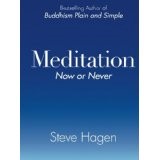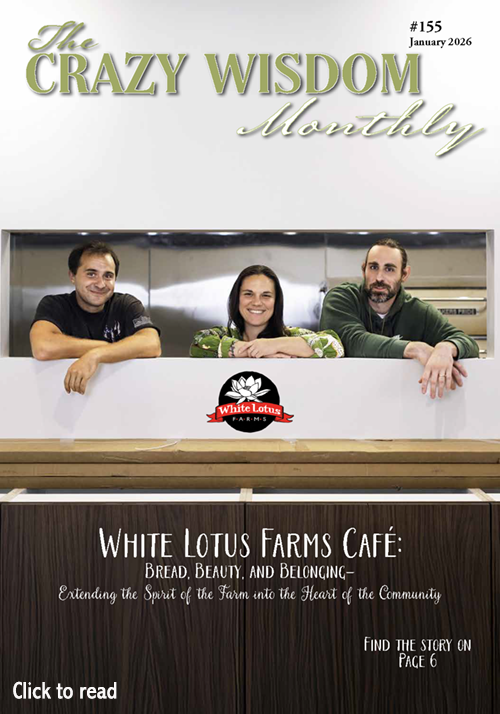by Nirmala Hanke
We all have a spiritual path. “Meditation is for everyone, eventually,” one of my spiritual teachers, Chetana Catherine Florida, used to say. Meditation is a practice of listening that helps us to move forward along our own particular spiritual path. You listen to the highest intelligence within, whether you call it God, your Higher Power, God/Goddess Consciousness, the Christ Light, the Buddha Nature, the Tao, whatever you wish to call it. We are all here for a reason, our own individual reason, whether we are aware of it or not. And if you believe in past lives, we have, according to the many accounts from near death experiences and communications from those who have passed on, made an agreement with ourselves before our current incarnation about what our purpose is, and what our goals in this lifetime will be. Meditation and other spiritual practices help us connect with that higher intelligence, the presence of the Divine within, so that we can more easily travel our path. So that we can do and be what we have come here to do and be.
My own path is not all that unusual or surprising, but it is unique to me, and it unfolded “in Divine Order,” God’s order, just as I needed it to. And while it is unique, there are some things I've encountered along the way that might be helpful to you or others. So here we go.
Shikantaza
My spiritual journey (consciously anyway) began as I was ending my Jungian analysis with David Hart in Swarthmore, Pennsylvania. My husband had gotten a job at the University of Michigan, and I was wanting to take something with me from my therapy. Since David Hart was a practicing Zen Buddhist, I asked him at our last appointment if he could teach me how to meditate. He said sure, and in a few words described a Zen meditation practice, shikantaza, which was essentially sitting and watching one’s thoughts. (For more on shikantaza, see Steve Hagen’s Meditation Now or Never.) Sounded simple enough; we meditated together for 20 minutes. That was it. I was launched. I did not meditate very regularly at first, what with the move to Ann Arbor, taking a leave of absence from psychiatry, and having Ben, our first child. But when Ben developed (what turned out to be a transient) heart irregularity, I prayed that he would be okay, and promised to begin daily meditation if he was. Well he was, and so I did.
For the next 10 years I meditated daily, eventually adding a second meditation. Since I am a private person and want to do many things alone, for a long time I was content to do my meditations, and for inspiration, read daily from Shunryu Suzuki’s Zen Mind, Beginner’s Mind or Stephen Mitchell’s translation of the Tao Te Ching. But after a while, even I had to admit that I was running into a stone wall of some kind: meditating daily was okay, but I somehow was not. I was no longer content going it alone.
A Course in Miracles
My first break from my solitary meditation practice came when my friend Arlene Reich introduced me to A Course in Miracles (ACIM), which she had been studying for a while. I took to it like a fish to water. We discussed it occasionally, but mainly I was supplementing my daily meditations with the daily workbook lesson. If you are familiar with ACIM, you know that the workbook has 365 lessons, one for each day. By the end of a year, you should be done. Well I discovered along the way that I wanted to dwell on certain lessons for more than a day. The lesson “Make No Judgments” was a good example; I could have spent a year on that one alone (indeed, I am still working on it to this day). I finally finished ACIM (workbook, text, and manual for teachers) after a couple years. During that time, I became quite aware of how much meditation had been helping me deal with a seemingly bottomless pit of anger. Anger that had not been touched really during my earlier therapy. Somehow the combination of 10 years of meditation and ACIM had brought the anger to the surface, to awareness, so that I could start to understand it and deal with it.
On its own, ACIM is a great way to develop a meditation practice. One of the implicit ideas in ACIM is to have the reader begin with meditating for 30 seconds at a time; by the end of the year-long course, the reader is meditating 20 minutes twice a day. If you are a self-starter, you might find that ACIM is a great way to develop a meditation practice. There is also a plethora of ACIM groups and publications, if you are interested. Miraclecenter.org can connect you to ACIM study groups; ACIM is also available as an online course. And Marianne Williamson’s A Return to Love is a good introduction to the principles of ACIM.
“Meditation is a practice for life.””
Mantra Meditation
For me the next step on my spiritual path was a women’s spirituality group. A number of like-minded women started meeting monthly in Ann Arbor in 1991, to explore different spiritual traditions. The next spring, a couple of the women (Karen Kerns and Alison Hine) reported to the group that they had just visited a psychic in Whitmore Lake, a Chetana Catherine Florida, and were very impressed. Alison said, “I’ve never met anyone like her.” That was enough for me. I scheduled a reading with her and by the end of May, not only had I had a reading, but I’d taken her introductory meditation lecture. This was a lot more detailed than David Hart’s necessarily brief instructions 10 years earlier. I learned about the four minds and the four things that happen in any meditation. We all were empowered with a mantra to meditate with. A mantra, Chetana said, “is a tool for the mind; it makes the work of meditation easier." I hadn't really thought of meditation as work before. She explained it this way, the four things that happen in meditation:
Mantra: puts rest into the nervous system
Thoughts: the work of meditation, releasing stress, memories, emotions from the nervous system, clearing mental space
Sleep: taken during meditation when one is too tired to release thoughts or to even say the mantra
Transcendence: that state beyond thought and mantra which connects to Divine Consciousness
So with the mantra I was off on a new meditation adventure! Within a couple of weeks however, I was concerned, as I was having headaches and a lot of anger surfacing in the meditations. Hadn't I taken care of that anger with A Course in Miracles? Apparently not. I mentioned this to Chetana; she looked at me and said, “That’s what happens with meditation, releasing.” Oh. So began the meditation journey that I am still embarked upon today: a journey of ever deepening awarenesses surfacing, releasing, and transforming.
When I took up the mantra meditation presented by Chetana, little did I know that I would also become part of a meditation community, the Lighthouse Center for spiritual development that she had started in 1979. In addition to the introductory meditation lecture, there were “intensive meditations” twice a month, lasting 2.5 hours, meditating through the seven chakra centers. And chakra classes, in which one could experience the energies at each chakra, meditating with a different mantra at each chakra. There was also training in Reiki healing. I was soon enlisted in all of this, and was beginning to appreciate the value of meditating with like-minded souls, all traveling their own particular paths but supporting each other and enjoying each other’s company.
Now some 20 years later, I am still meditating at the Lighthouse Center, attending the biweekly intensive meditations, and teaching the chakra classes that Chetana used to teach, as well as her monthly introductory meditation lecture (if you would like to attend, contact Prachi Patricia Thiel at (734) 417-5804, or cprachi17@gmail.com). Chetana transcended 11 years ago, and while the Lighthouse community grieved her passing, she remains in our hearts as an inspiration to all who knew her. We continue on with the teachings she gave us, as well as the guidance and teachings provided by her teacher and our spiritual advisor, Gurudev Shree Chitrabhanuji, and his wife Pramodaji.
I will have a lot to say in the next blog about Chitrabhanuji, a Jain Master who is now almost 92, and his influence at the Lighthouse Center, bringing spiritual practices beyond meditation. Practices such as fasting, service, silence, and a vegan lifestyle. But for now, let me just share one thing he has said about meditation: “Meditation is a practice for life.”
Why Meditate?
According to the religions of the East, we are always accumulating karmas, through our every thought, word, and action. There are detailed and complicated theories about karma; the Jains, for example, have delineated 108 of them. One easy way to think of karma is the Christian “you reap what you sow,” or “what goes around comes around.” We have all experienced that. Meditation and other spiritual practices, such as fasting, service, silence all help to erase, clear out these karmas from our chakras, our minds, our bodies.
But before I give the impression that meditation is just a lot of hard work, let me mention some of the many benefits of taking time out every day to listen to the Divine within. Here are a few of them:
1- Relaxation of body and mind
2- Increasing clarity in thoughts, words and actions
3- Becoming centered, grounded
4- Feeling less stressed out, anxious, depressed
5- More happiness, contentment, joy
6- Learning to be in the present moment
7- Letting go and going with the flow
8- More gratitude
9- Forgiving self and others
10-Loving self and others more
I could go on; you get the idea. And you can make your own list. Each of you will find that meditation, practiced on a daily basis, will begin to slowly change and transform you, as old negative habits give way to new, more life affirming ones. Meditation becomes a habit; meditating once or now and again will not reap the benefits mentioned above; a daily meditation practice will. Guaranteed. Chetana used to say, in her introductory meditation lecture: “Meditation is the vehicle that takes you where you need to go in your nervous system.” Sometimes it will take you to old “stress pockets” of negative thoughts or feelings needing to be released, sometimes it will take you to new insights and aha! moments. Trusting the process of meditation is really just trusting yourself. Trusting that somewhere, deep inside you, the Divine within you knows where you need to go, in your meditation, in your life. One meditation at a time, one day at a time.
Another window into the value of meditation are these words from Buddhist Pema Chodron in her book Comfortable With Uncertainty:
When we sit down to meditate we leave behind the idea of the perfect meditation, the ideal meditation, and preconceived results. We train in simply being present. We open ourselves completely to the pain and the pleasure of our life. We train in precision, gentleness, and letting go. Because we see our thoughts and emotions with compassion, we stop struggling against ourselves. We learn to recognize when we’re all caught up and to trust that we can let go. (pg. 141)
Meditation, in the end, is a gift we can give ourselves each day. As our trust in our inner light, the Divine within, grows, we become freer and more fulfilled in following our spiritual path. Snatam Kaur, an American Sikh living in New Mexico, sings a lovely Irish blessing to close her kundalini yoga classes:
“May the long time sun shine upon you.
All love surround you.
And the pure light within you guide your way on.
Guide your way on.”
If you are not already a meditator, I hope you will give it a try, the pure light within you guiding your way on.
Namaste,
Nirmala
Nirmala Hanke is a practicing psychiatrist and psychotherapist, and recently retired medical director at Monroe Community Mental Health Authority. She has a private practice in Whitmore Lake for psychiatry, meditative psychotherapy, and Reiki healing. She has been meditating the last 30-odd years, first in the Zen tradition, and the last 20 years in the Jain mantra tradition. She teaches introductory and advanced meditation classes at the Lighthouse Center based upon Chitrabhanuji’s Jaina teachings, including The Psychology of Enlightenment: Meditations on the Seven Energy Centers. For more information on the Lighthouse Center, seelighthousecenterinc.org.
Related Content:







































































































































































































By Dr. Nirmala Nancy Hanke | Photos by Joni Strickfaden
"Your life is a grand adventure. Take risks. Explore the unknown.
Journey forth into the great wide open without preplanned outcomes."
– from The Original Angel Cards Book by Kathy Tyler and Joy Drake
This quote certainly applies to the phase of life we call retirement. One of my friends, who retired three years ago, checked in with me recently to see how retirement is going